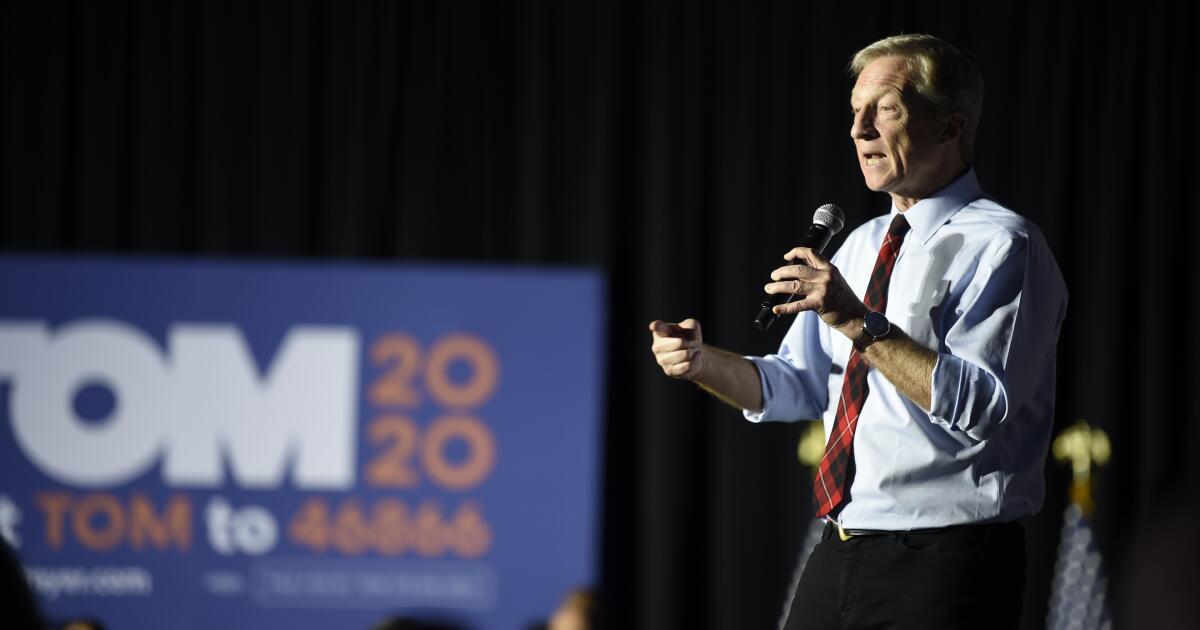California has its most wide-open governor’s race in decades
Today we discuss Texas, overreaction and the voluminous field of candidates for California governor.
Is there anyone who is not running for governor?
I’m not. And neither are my two cats. At least they weren’t as of this morning, when we discussed the race before breakfast.
That leaves us somewhat short of the 135 candidates who ran in California’s 2003 recall gubernatorial election. But not by much.
I count nearly a dozen serious candidates, with possibly more to come. Why so many?
Opportunity.
This is the most wide-open race for California governor in decades. By comparison, you’d have to go back to at least 1998, when Lt. Gov. Gray Davis surged past a pair of moneybag candidates, Al Checchi and Rep. Jane Harman, in the Democratic primary, then stomped Republican Atty. Gen. Dan Lungren in November to win the general election.
Now, as then, there is no one who even remotely resembles a prohibitive front-runner.
Polling in the governor’s race has shown former Democratic Rep. Katie Porter and Chad Bianco, Riverside County’s Republican sheriff, narrowly leading the field. But with support for both in the middling 13%-to-21% range, we’re not talking about a pair of world-beaters.
Like nature, political ambition abhors a vacuum.
Speaking of moneybags…
Yes.
After making a bundle as a hedge fund manager, the San Francisco billionaire and environmental activist has been panting after public office for years. Running for president didn’t work out in 2020, even after Steyer spent more than $345 million on his effort. (That’s close to what the Dodgers spent on their 2025 payroll.)
So now Steyer is running for governor, a move he appeared to telegraph by airing nearly $13 million in self-promotional ads that, oh yes, supported passage of Proposition 50, the Democratic gerrymander initiative.
What are his chances?
Longtime readers of this column — both of you! — will know I make no predictions.
But California voters have never looked favorably upon rich candidates trying to make the leap from political civilian to the governorship or U.S. Senate. In fact, over the last 50-plus years, a gilded gallery of the well-to-do have tried and spectacularly failed.
Perhaps Steyer will display the policy chops or the razzle and dazzle they all lacked. But his launch video certainly didn’t shatter any molds. Rather, it presented a stereotypical grab bag of redwood trees, potshots at Sacramento, multicultural images of hard-working-everyday-folk, a promise to fight, a pledge to build more housing and, of course, a dash of profanity because, gosh darn it, nothing says “unbridled authenticity” like a political candidate swearing!
Maybe his fellow billionaire, Rick Caruso, will show more creativity and imagination if he gets into the governor’s race.
At least Democrats have been showing signs of life.
Indeed. Dare I say, the party’s mood swing from near-suicidal to euphoric has been quite something.
Winning gubernatorial elections in New Jersey and Virginia — not by a little, but a lot — and prevailing in down-ballot contests in Pennsylvania and Georgia had a remarkably transformative effect. (Zohran Mamdani’s mayoral victory in sky-blue New York City was no big surprise once the democratic socialist prevailed in the primary.)
Literally overnight, Democrats seized the momentum heading into the 2026 midterm election, while Republicans have begun scrambling to reposition their party and recraft its messaging.
All that being said, even before their buoyant off-year performance those widespread reports of Democrats’ demise were greatly … well, we’ll leave that Mark Twain chestnut alone. As analyst Charlie Cook points out, 2024 was a deeply disappointing year for the party. But it wasn’t a disaster.
Democrats gained two House seats. There was no net change in any of the 11 gubernatorial races and legislative contests across 44 states ended in something close to a wash. The party lost four Senate seats — and control of the chamber — but three of those losses came in the red states of Montana, Ohio and West Virginia.
“This is not to argue that Democrats had a great night in November 2024, but it certainly wasn’t a massacre or a party-wide repudiation,” Cook wrote in a recent posting. “If voters had intended to take it out on the party as a whole, the results would have looked quite different.”
Rather than a wholesale takedown of Democrats, the result seemed very much a rejection of President Biden and, by extension, his hasty replacement on the ballot, Vice President Kamala Harris.
What does that mean going forth?
If you’re asking whether Democrats will win control of the House or Senate…
Yes?!?
…I haven’t a clue.
Democrats need to gain three seats to take control of the House and both history and Trump’s sagging approval ratings — especially as pertains to the economy — augur well for their chances. The president’s party has lost House seats in 20 of the last 22 midterm elections and, according to Inside Elections, the fewest number of seats that flipped was four.
That’s why I thought Proposition 50, which sets out to all but decapitate California Republicans in Congress, was a bad and unnecessary move, effectively disenfranchising millions of non-Democratic voters.
An appeals court last week tossed out a Republican gerrymander in Texas, putting Democrats in an even stronger position, though the legal wrangling is far from over. The Supreme Court temporarily blocked the decision, pending review. And still to come is a high court ruling that could gut the Voting Rights Act and yield Republicans a dozen or more House seats nationwide.
So the fight for control is far from decided.
As for the Senate, Republicans stand a much better chance of keeping control, given how the seats contested in 2026 are located on largely favorable GOP terrain.
But until the votes are counted, nobody knows what will happen. That’s the thing about elections: they help keep wiseacres like me honest.

